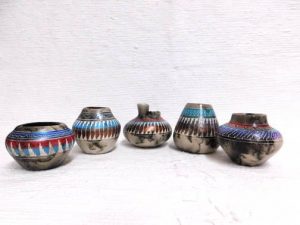The Origins and Original Purposes of Horse Hair Pottery
As with many other traditions, the precise origin of horsehair pottery is lost to time. It’s well known, however, that horses first arrived in the American Southwest with the Spanish at the start of the 17th century, and were commonplace among the Southwestern peoples by 1660.
Even so, there are many stories and legends about the origin of the pottery. Well-legend says that this type of pottery was created when a young woman removed hot pottery from her kiln. A gust of wind blew her long hair onto the hot clay and burned her hair into it, leaving behind dark lines and cloudy grey from the smoke. Whatever the true origins, this type of pottery was made to honor horses and celebrate the births of new foals. Today, this type of pottery is primarily decorative in nature, but some pots are still made for traditional honor celebrations.
How Is This Pottery Made?
It starts by being poured into a mold and fired inside a kiln like other ceramic pottery. The pottery is removed after a short time before it fully hardens. Hair from a horse’s mane and the tail is then applied to create unique lines. The grey areas come from the burning hair and the resulting smoke. The pottery is then returned to the kiln to finish the firing process. Finally, it is etched and spray-glazed.
How Is It Painted and Etched?
While the clay is still soft, the pottery is placed on a wheel. Modern pottery uses commercial paints and damp sponges to get smooth colors across the work. Designs are then etched by incising a design onto the pot through the layer of paint.
What Kinds of Etchings Are There?
Those looking for etched pottery will find it more among the Navajo than other Southwestern peoples. Navajo artisans prefer to etch traditional symbols even on contemporary pottery designs. These symbols include mountains, rain, whirlwinds, lightning, friendship, kachinas, corn, and a variety of animals and insects. Each symbol is considered a prayer to one of the many gods in Navajo customs.
Is Our Pottery Authentic?
At Kachina House, all of our pottery is done by Native American artisans in the southwest. Each piece comes with a certificate of authenticity that provides the name and tribal affiliation of the artist. Visit our store or stay on this website and shop our beautiful selection of Native American ceramic horsehair pottery.

